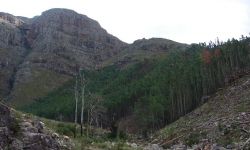Exploring Working for Water success stories
Invasion by alien plants poses a significant threat to South Africa’s biodiversity and human well-being. Ecosystem services are under pressure largely due to this threat. The Department of Environmental Affairs is tasked with bringing the invasion threat under control and its WfW programme is tackling the problem head-on.
The WfW programme was specifically set up in 1995 for the management of invasive alien plants (IAPs) to conserve water and to provide employment to marginalised sectors of South African society. The programme has been criticised for not bringing the invasion problem under control, despite having been in operation for nearly two decades, with associated total expenditure in the region of billions of rand.
However, there are some projects that have resulted in previously heavily invaded ecosystems being returned to a state nearing pre-invasion conditions. Applying a case study design, CSIR researchers show what WfW has achieved and why the chosen examples have been successful. Three projects selected in consultation with WfW managers are assessed, each representing an example of the different implementation models used in WfW:
| Model | Implementing agent | Herbicide assistance | Land user incentive |
| Brief description | WfW appoints a government agent (e.g. a municipality; etc.) to manage the day-to-day operations of a clearing project while WfW funds and oversees (e.g. through periodic verification) the project. | Typically used to help private landowners manage IAPs on their property. WfW supplies the herbicide/s needed to control IAPs, but the operations are handled by the landowner. | Interested land users and land owners participate in a competitive bidding process for funds to control IAPs. Applicants have to demonstrate the availability of co-funding from stakeholders of the proposed project. |
| Case study | Berg River Dam | Phinda Private Game Reserve | Upper uMzimvubu Catchment |
| Extent of project (ha) | 11 600 | 13 000 | 4 000 |
| Project duration | 2001-present The Berg River Dam project has undergone several changes in management since its inception. |
2001-present | 2013-present |
| Major problem species | Acacia spp.; Eucalyptus spp.; Pinus spp. | Chromolaena odorata; Lantana camara | Acacia mearnsii |
| Land ownership | State and private | Private | Communal |
| Biophysical benefits gained | Increase in water quality and quantity; biodiversity | Increase in tourism potential | Increase in grazing capacity; soil retention |
In all three projects invasion levels have been reduced significantly, with a concomitant increase in the targeted ecosystem services, viz: provision of water; tourism potential and grazing land, respectively.




